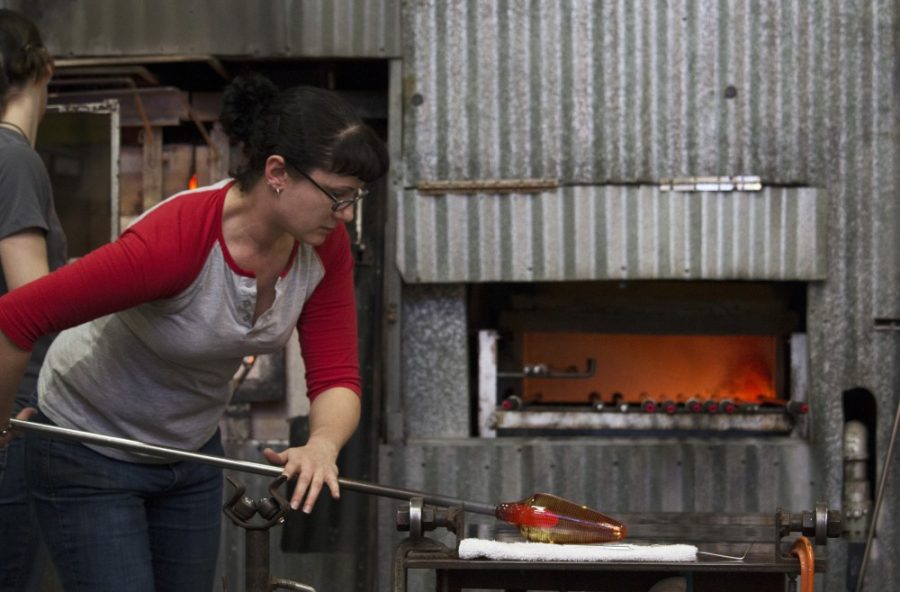Tucson’s art community is home to a variety of ways for locals to experience the art of glassmaking.
The Philabaum Glass Gallery and Studio is a free gallery located in downtown Tucson with a variety of glass art from various artists, including Tom Philabaum, founder of the gallery and co-founder of the Sonoran Glass School. The gallery will soon transition from the “Pro-fus-ion exhibition, featuring the fused glass artwork of Richard Parrish and Karen Bexfield, to the spring exhibition, “North Carolina Perspectives.
Dabney Philabaum, wife of Tom Philabaum, said Bexfield and Parrish work with disparate pieces of compatible glass, mass and heat in a kiln to create their art. Parrish’s collection includes numerous tapestry plates, which are made with linear patterns of glass pieces. This style creates textures similar to those of hand-woven fabrics, which are an inspiration to Parrish’s work.
The “Pro-fus-ion” exhibit’s last showing date will be Jan. 30.

The spring exhibition reception will be held on Feb. 4, and the exhibit will be available for viewing through May 27. The spring exhibition is a survey of five artists who represent North Carolina’s glass makers using the Casting, Batutto, Flameworking and Filigrana methods.
RELATED: Glassblower Micah Blatt is the gem of his own bar: Mr. Head’s
Locals have the opportunity to learn how to make their own glass artwork at the Sonoran Glass School. Virgil Jones, administrative assistant and hot shop assistant at the Sonoran Glass School, said Tom Philabaum and Dave Klein founded the school in 2000c and have since been able to expand the school to further incorporate the warm and flame shops together with the hot shop. The different shops each center around a different area of glass art techniques.
The glass blowing process is said to be lengthy for artists.
“The molten glass is heated to approximately 2,050 degrees Fahrenheit and cools quickly,” Jones said.
Artists pull a blob of molten glass gathered onto the end of a steel blowpipe from the 400-pound HUB furnace. This is the very first step in the process. Artists then roll the melted glass on a steel table to give the blob a shape before returning it to the “Glory Hole” in the furnace to keep the glass heated. Artists can add color to the piece by rolling the melted glass over a form of colored glass, such as powders, then returning the piece to the “Glory Hole” so the colored glass can melt into the clear glass.
The artist completes these steps while maintaining constant motion to preserve the shape of the piece. After coloring, the artist can begin blowing into the pipe to create a bubble before returning it to the “Glory Hole”. The artist has a few more steps to fully complete the piece, some of which require assistance to ensure the artwork does not drop or crack.

Bronwen Heilman, flame shop director at the School, has taught in the flame shop since 2014 and has been a member of the SGS Board since 2011. Heilman discovered her interest in glass art around the age of five during a visit to Disneyland, where she was fascinated by a man at work.
RELATED: Museum of Art reveals the science of art conservation
Sonoran Glass School will soon be hosting its annual Flame Off torchworking competition where 18 artists compete in making a glass art piece that follows the competition’s theme. This year’s theme is “The Textures and Sparkle of Tucson’s Gem Show.”
Though the Philabaum Glass Gallery and Studio are free to the public, the classes at the Sonoran Glass School can cost anywhere from $75 to $550 for nonmembers. If you decide to become a member of SGS, the price of a one-year membership is $30 for students with a valid identification card and $40 for individuals.
Jones said UA and Pima Community College students could also take classes at Sonoran Glass School and receive credit for ART 265 or ART 266. The three-month courses focus on furnace glassblowing and run between Feb. 6 and April 12. For more information, visit www.sonoranglass.org or www.philabaumglass.com.
Follow Kirshana Guy on Twitter.









